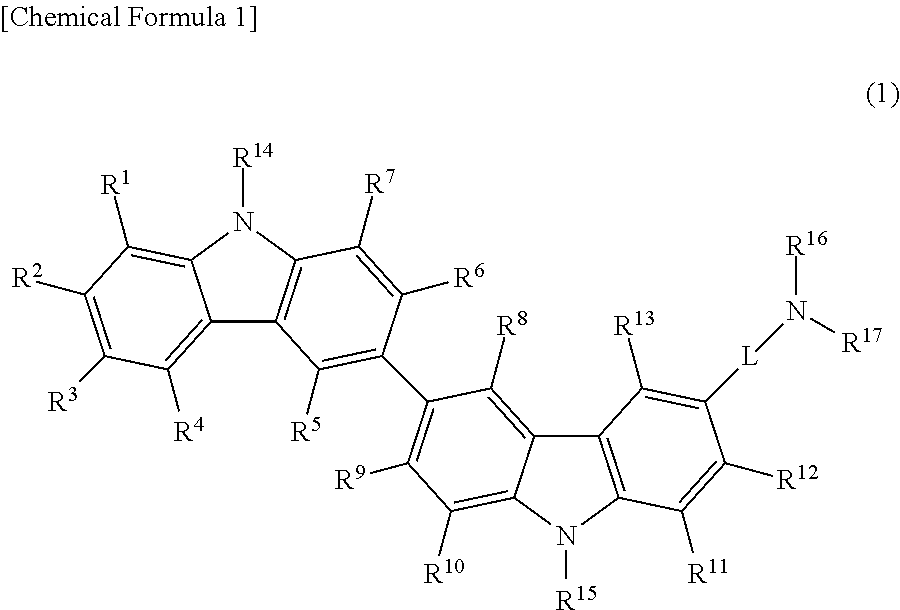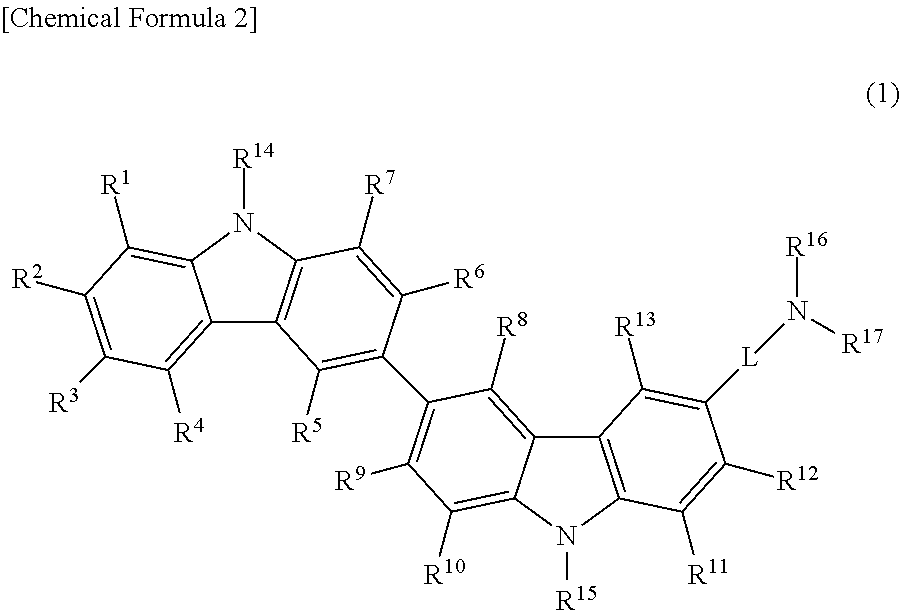Light emitting device material and light emitting device
a technology of light emitting device and material, which is applied in the direction of thermoelectric devices, triarylamine dyes, organic chemistry, etc., can solve the problems of insufficient luminance efficiency and device durable life, inability to achieve low driving voltage, and insufficient technology for achieving low driving voltage and durable life. , to achieve the effect of long lasting life, low driving voltage and high luminance efficiency
- Summary
- Abstract
- Description
- Claims
- Application Information
AI Technical Summary
Benefits of technology
Problems solved by technology
Method used
Image
Examples
synthesis example 1
Synthesis of Compound [71](HT-1)
[0090]A mixed solution of 20.9 g of 3,6-dibromophenylcarbazole, 15.0 g of phenylcarbazole-3-boronic acid, 366 mg of bis(triphenylphosphine) palladium (II) dichloride, 105 ml of a 1M aqueous sodium carbonate solution, and 260 ml of dimethoxyethane was refluxed for 5 hours under a nitrogen flow. After cooling to room temperature, extraction with toluene was conducted. The organic layer was washed with water twice, dried over magnesium sulfate, and evaporated. The resultant concentrate was purified by silica gel column chromatography and then vacuum-dried to obtain 13.5 g of 6-bromo-9,9′H-3,3′-bicarbazole.
[0091]Next, a mixed solution of 5.3 g of 6-bromo-9,9′H-3,3′-bicarbazole, 3.0 g of 4-(diphenylamino)phenylboronic acid, 66 mg of bis(triphenylphosphine)palladium (II) dichloride, 21 ml of a 1M aqueous sodium carbonate solution, and 47 ml of dimethoxyethane was refluxed for 5 hours under a nitrogen flow. After cooling to room temperature, water was poured...
example 1
[0095]A glass substrate with an ITO transparent electrically conductive film deposited thereon in a thickness of 165 nm (manufactured by GEOMATEC Co., Ltd., 11Ω / □, sputtered product) was cut into 38×46 mm, and then subjected to etching. The resulting substrate was ultrasound-washed with “SEMICOCLEAN 56” (trade name, manufactured by Furuuchi Chemical Corporation) for 15 minutes, and then washed with ultrapure water. This substrate was treated with UV-ozone for 1 hour immediately before manufacturing of a device, and placed in a vacuum evaporation apparatus, and the air was evacuated until the degree of vacuum in the apparatus was 5×10−4 Pa or lower. By a resistance heating method, HI-1 was evaporated as a hole injection layer in a thickness of 10 nm. Then, HT-1 was evaporated as a hole transporting layer in a thickness of 60 nm. Then, Compound H-1 and Compound D-1 were used as a host material and as a dopant material, respectively, and were evaporated as an emissive layer in a thickn...
examples 2 to 19
[0097]According to the same manner as in Example 1 except that materials described in Table 1 were used as a hole transporting layer, light emitting devices were manufactured and evaluated. The results are shown in Table 1. HT-2 to HT-19 are compounds shown below.
PUM
 Login to View More
Login to View More Abstract
Description
Claims
Application Information
 Login to View More
Login to View More - R&D
- Intellectual Property
- Life Sciences
- Materials
- Tech Scout
- Unparalleled Data Quality
- Higher Quality Content
- 60% Fewer Hallucinations
Browse by: Latest US Patents, China's latest patents, Technical Efficacy Thesaurus, Application Domain, Technology Topic, Popular Technical Reports.
© 2025 PatSnap. All rights reserved.Legal|Privacy policy|Modern Slavery Act Transparency Statement|Sitemap|About US| Contact US: help@patsnap.com



